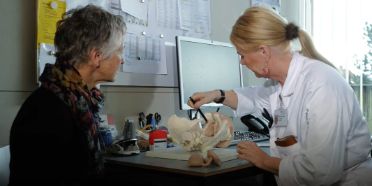PFM Impact
There is a body of evidence that pelvic floor muscles (PFM) have to contract strongly and reflexively in order to grant continence. Up to now the focus of research on muscle function has been on the concentric and isometric muscle action.
Factsheet
- Lead school School of Health Professions
- Additional schools School of Engineering and Computer Science
- Institute Physiotherapy
-
Research unit
IRPT / Rehabilitationstechnik
Pelvic Floor Health
I4MI / Digital Health Lab - Funding organisation BFH
- Duration 01.01.2015 - 31.12.2017
- Project management Prof. Dr. Lorenz Radlinger
- Head of project Prof. Dr. Lorenz Radlinger
-
Project staff
Dr. Helene Moser
Prof. Dr. Monika Leitner
Prof. Dr. Kenneth James Hunt
Prof. Dr. Lorenz Radlinger
Dr. Jacqueline De Jong
Prof. Dr. med. Annette Kuhn -
Partner
Universitätsspital Bern
Physio Artos Interlaken
Physiotherapie Helmos - Keywords cross sectional study, electromagnetic tracking, electromyography
Situation
So far no light has been shed on the reflexive type of contraction and displacement during impact loading on the PFM, like in coughing, running, jumping activities that typically provoke incontinence.
Course of action
PFM displacement can be recorded with an electromagnetic tracking system, complemented by vaginal surface electromyography that displays concurrent electrical activity during functional activities. The presented study aims at a deeper understanding of PFM kinematics and activity during impact and therefore helps to elucidate PFM action related to incontinence pathophysiology. The outcomes would instantly benefit the PFM diagnosis and development of specific training programs.
Result
The pelvic floor muscle activity is higher than the resting activity in all measured exercises and therefore potentially therapeutically effective. It increases with increasing intensity (speed, jump height, etc.). The kinematics of the pelvic floor during impacts does not lead to a stretch-shortening cycle (eccentric-concentric) as assumed. - increases in magnitude with increasing intensity.
Looking ahead
Exercises generating involuntary, reflexive activation of the pelvic floor muscles are added to current therapy concepts. Further studies reflexive activation and kinematics of the pelvic floor muscles are planned.

